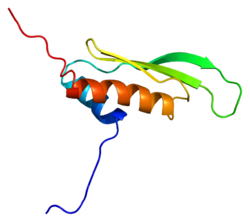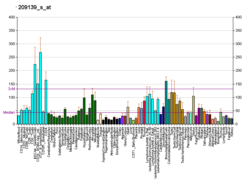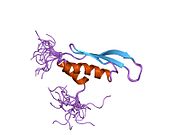
Interferons are a group of signaling proteins made and released by host cells in response to the presence of several viruses. In a typical scenario, a virus-infected cell will release interferons causing nearby cells to heighten their anti-viral defenses.
The NS1 influenza protein (NS1) is a viral nonstructural protein encoded by the NS gene segments of type A, B and C influenza viruses. Also encoded by this segment is the nuclear export protein (NEP), formally referred to as NS2 protein, which mediates the export of influenza virus ribonucleoprotein (RNP) complexes from the nucleus, where they are assembled.

Protein kinase RNA-activated also known as protein kinase R (PKR), interferon-induced, double-stranded RNA-activated protein kinase, or eukaryotic translation initiation factor 2-alpha kinase 2 (EIF2AK2) is an enzyme that in humans is encoded by the EIF2AK2 gene.

Interferon regulatory factor 3, also known as IRF3, is an interferon regulatory factor.

Non-receptor tyrosine-protein kinase TYK2 is an enzyme that in humans is encoded by the TYK2 gene.

Interleukin enhancer-binding factor 3 is a protein that in humans is encoded by the ILF3 gene.

Eukaryotic translation initiation factor 2 subunit 1 (eIF2α) is a protein that in humans is encoded by the EIF2S1 gene.

The double-stranded RNA-specific adenosine deaminase enzyme family are encoded by the ADAR family genes. ADAR stands for adenosine deaminase acting on RNA. This article focuses on the ADAR proteins; This article details the evolutionary history, structure, function, mechanisms and importance of all proteins within this family.

Inhibitor of nuclear factor kappa-B kinase subunit epsilon also known as I-kappa-B kinase epsilon or IKK-epsilon is an enzyme that in humans is encoded by the IKBKE gene.

Interferon regulatory factor 9 is a protein that in humans is encoded by the IRF9 gene, previously known as ISGF3G.

Eukaryotic translation initiation factor 2 subunit 2 (eIF2β) is a protein that in humans is encoded by the EIF2S2 gene.

Double-stranded RNA-binding protein Staufen homolog 1 is a protein that in humans is encoded by the STAU1 gene.

Eukaryotic translation initiation factor 2 subunit 3 (eIF2γ) is a protein that in humans is encoded by the EIF2S3 gene.

Interferon-induced protein with tetratricopeptide repeats 1 is a protein that in humans is encoded by the IFIT1 gene.

DnaJ homolog subfamily C member 3 is a protein that in humans is encoded by the DNAJC3 gene.

MDA5 is a RIG-I-like receptor dsRNA helicase enzyme that is encoded by the IFIH1 gene in humans. MDA5 is part of the RIG-I-like receptor (RLR) family, which also includes RIG-I and LGP2, and functions as a pattern recognition receptor capable of detecting viruses. It is generally believed that MDA5 recognizes double stranded RNA (dsRNA) over 2000nts in length, however it has been shown that whilst MDA5 can detect and bind to cytoplasmic dsRNA, it is also activated by a high molecular weight RNA complex composed of ssRNA and dsRNA. For many viruses, effective MDA5-mediated antiviral responses are dependent on functionally active LGP2. The signaling cascades in MDA5 is initiated via CARD domain. Some observations made in cancer cells show that MDA5 also interacts with cellular RNA is able to induce an autoinflammatory response.

52 kDa repressor of the inhibitor of the protein kinase is an enzyme that in humans is encoded by the PRKRIR gene.

Cyclin-dependent kinase-like 2 is an enzyme that in humans is encoded by the CDKL2 gene.

C16 is a drug which acts as a selective inhibitor of the enzyme double-stranded RNA-dependent protein kinase (PKR). It has been shown to effectively inhibit PKR function in vivo and has neuroprotective and nootropic effects in animal studies.

The mammalian immune system has evolved complex methods for addressing and adapting to foreign antigens. At the same time, viruses have co-evolved evasion machinery to address the many ways that host organisms attempt to eradicate them. DNA and RNA viruses use complex methods to evade immune cell detection through disruption of the Interferon Signaling Pathway, remodeling of cellular architecture, targeted gene silencing, and recognition protein cleavage.

























